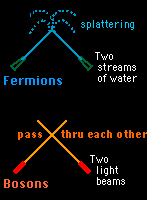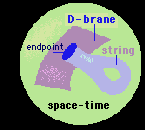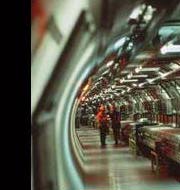A new Hypothesis : String Theories |
 Many particle theorists independently realised that earlier theories describing
Many particle theorists independently realised that earlier theories describingthe particle spectrum also described the quantum mechanics of an oscillating string, and the concept of String Theory was born. String theory may have the capability to show that all of the happenings in the universe - from the dance of subatomic quarks to the movements of orbiting binary stars, from the big bang to the whirl of celestial galaxies - are reflections of one grand physical principle, one master equation.
Note: |
|
Strings : Exploring the Unknown
String theory is at this moment the most promising candidate theory for a unified description of the fundamental particles and forces in nature including gravity. In string theory all the forces and particles emerge in an elegant geometrical way, realizing Einstein's dream of building everything from the geometry of space-time. |
| space-time: a union of space and time originally emerging from special relativity. Can be viewed as the ' fabric ' out of which the universe is fashioned; it constitutes the dynamical arena within which the events of the universe take place. |
| String theory is based on the premise that at the smallest scale particles are actually one- dimensional objects, unlike an elementary particle which is zero-dimensional. | |
|
| |
|
- strings sweep out a two-dimensional surface, called a
worldsheet, analogous to the one-dimensional worldline traced out by a point particle. |
String theories replace the basic principle of pointlike particles with the idea
that the elementary excitations of our universe are not particles but incredibly small vibrating loops of strings.
 In contrast with particle theories, string theory is highly constrained in the choice of interactions. In fact, all the usual particles emerge as excitations of the string and the interactions are simply given by the geometric splitting and joining of these strings |
|
According to string theory, absolutely everything in the universe - all of the
particles that make up matter and forces - is comprised of tiny vibrating fundamental strings.
Moreover, every one of these strings is identical. The only difference between one string and another,
whether it's a heavy particle that is part of an atom or a massless particle that carries light, is its
resonant pattern, or how it vibrates.
In order to produce such variety, strings have to wiggle in more complex patterns than are possible in three dimensions, so string theory requires at least six additional ones. To have gone unnoticed all this time, these dimensions must be curled up like submicroscopic origami. |
 The strings are multi-dimensional and geometrical - the interactions of one multi-
dimensional shape with another
produces the effects we call forces, just as the 'force'
The strings are multi-dimensional and geometrical - the interactions of one multi-
dimensional shape with another
produces the effects we call forces, just as the 'force'of gravity in general relativity is what we feel as we move through the curves of four-dimensional space-time. And they unify, no doubt about it: in the math, at least, all of nature from quantum mechanics to gravity potentially may emerge from the equations of string theory. |
| Unfortunately strings are way too small to see by current or expected particle physics technology. According to some theories the length of one string would be 10-33 centimeters, or about a millionth of a billionth of a billionth of a billionth of a centimeter, and so string theorists must devise purely mathematical methods (or perhaps look at cosmological relics of the big bang) to test their theories rather than looking for little strings in particle experiments at accelerators. |
|
Note : The length of 10-33 centimeters is called a Planck length. That is the scale below which quantum fluctuations in the fabric of spacetime would become enormous. The Planck length is the size of a typical string in string theory. |
| Basic String Theory Web site |
|
Over the years several string theories have been proposed: some deal only with bosons (particles that transmit forces);
others deal with fermions (particles that make up matter); some others wind up needing supersymmetry, which means an equal matching between bosons and fermions. Supersymmetric string theories are called Superstring Theories.
But the number of string theories has been shrinking in recent years, because string theorists are discovering that what they thought were completely different theories were in fact different ways of looking at the same theory ! And now the biggest rush in string research is to collapse the different theories into one theory, which some people want to call M - Theory, for it would be the 'Mother of all theories'. M also stands for Magic, Mystery or Matrix. |
|
The issue of Supersymmetry
For string theorists the world seems to be composed of two major parts. One part consisting of fermions (particles that make up matter) and a part consisting of bosons (energy particles that transmit forces). |
|
The diagrams on the right demonstrate the different properties of fermions and bosons.
If we use two garden hoses and aim two streams of water
But bosons (energy particles) have different properties. If, for example, two light beams of flashlights ( bosons) are aimed at each other the two beams pass right through each other, nothing at all happens. *
* There is actually a process whereby light scatters from light |

|
| The Pauli Exclusion Principle | Spin - Fermions - Bosons |
|
What's strange about the world is that stuff like us seems mostly to be fermions. The other half - energy, light, gravity - are all bosons. So why does the universe have this strange dichotomy, where matter cannot pass through each other, but light and energy can? The question arises : Wouldn't the world be more balanced, more symmetrical, if there were some forms of energy that would scatter each other just the way that matter does, and if there were some forms of matter that could pass right through each other just the way energy does? That's the basic idea of supersymmetry - to say that both, matter and energy, can either be fermion or boson. The idea of supersymmetry breaks an interesting stereotype. To break that stereotype is the idea of supersymmetry. It's purely hypothetical, but physiscists hope it's there, because it will be very interesting for future centuries. |
|
Refinement of String Theory + Introduction of Branes ( The word brane is borrowed from the word membrane ) Most versions of string theory involve two types of string : closed strings which connect upon themselves to form closed loops, and open strings with unjoined endpoints. |


|
|
Energy can flow along a string, slipping off the endpoint of an open string and vanishing ! This poses a problem : " conservation of energy dictates that energy should not be able to disappear from the system. " Therefore, a consistent string theory must include places into which energy can flow once it leaves a string. |
|
One of the consequences of this has been the realisation that string theory does not only include strings but also various higher dimensional objects, known as branes. Much interest has been focused on D-branes, named for Johann Dirichlet. ( Dirichlet boundary conditions have long been used in the study of fluids where they involve specifying some quantity all along a boundary. In fluid dynamics, fixing a Dirichlet boundary condition could mean assigning a known fluid velocity to all points on a surface ) |
 The D-brane is simply a place in space- time where the string can begin or end.
The D-brane is simply a place in space- time where the string can begin or end.Any version of string theory which allows open strings must necessarily incorporate D-branes, and all open strings must have their endpoints attached to these branes. In the example here an open string loops back to form a single endpoint, which is attached to a D-brane. D-branes are dynamical objects which have fluctuations and can move around. |
Open strings can have two different kinds of boundary conditions. In one condition the endpoint is free to move about but no momentum flows out.
In another condition the endpoint is fixed to move only on some manifold, called a D-brane. For example we see open strings with one or both end-
points fixed on a 2-dimensional D-brane.
 In this diagram we see one way in which a closed string can interact with a D2-brane
In this diagram we see one way in which a closed string can interact with a D2-brane( A D2-brane denotes a two dimensional brane.) Notice how the closed string becomes an open string with endpoints on the D-brane at the intermediate point in the interaction. |
|
Recapitulation
brane: any of the extended objects that arise in string theory. A one-brane is a string, a two-brane is a membrane, a three-brane has three extended dimensions, etc. More generally, a p-brane has p spatial dimensions. The multidimensional aspects of string theory lead into a microscopic world of so-called curled-up dimensions. curled-up dimension: a spatial dimension that does not have an observably large spatial extent; a spatial dimension that is crumpled, wrapped, or curled up into a tiny size, thereby evading direct detection. |
| Future expectations |
|
An important question today is: What is the best hope for finding some experimental support for the predictions of string theory? One possibility is a specific prediction of supersymmetry - which demands that for every particle there should be a partner particle. None of the supersymmetry partner particles have yet been discovered, but if current ideas are roughly right then physicists should be getting very close to discovering some of these and there seems to be a reasonable chance that one or more of them might turn up at the next large collider to be built, which is one that will be completed in CERN, Switzerland, after the year 2008. As it stands, string theories are unproved, and perhaps unprovable, as they involve interactions at energy levels far beyond any we can handle. But they are beautiful, to those versed enough in the language of mathematics to follow them. And in their beauty (and perhaps in their impenetrability) they are the heirs to Einstein's - unsuccessfull - attempts to produce a unified field theory. |
| Strings, branes, and curled-up dimsensions are at the present time highly speculative ideas. But supporters of string theory point out that the famous mathematical inconsistency, which for decades made it impossible to incorporate quantum gravity in a theory along with the other interactions, is conspicuous by its absence in string theory. It is almost as if gravity needs strings in order to exist! |
|
REALITY CHECK At this point it is usefull to remind ourself that string theories rest on assumptions which have not been proven experimentally. We still don't know if string theory may be the right theory of nature. |
||
| Prominent critics include Peter Woit, mathematician at Columbia University. | ||
|
A critical evaluation of string theory
by Peter Woit, Jan. 29, 2001 |
||
|
|
||
| ADDENDUM |
| The Research Tools : The Accelerators |
|
CERN - "Conseil Européenne pour la Recherche Nucléaire"
CERN is the European Organization for Nuclear Research, the world's largest particle physics centre, near Geneva airport, in Switzerland.
CERN is a laboratory where scientists unite to study the building blocks of matter and the forces that hold them together. CERN exists primarily to provide them with the necessary tools. These are accelerators, which accelerate particles to almost the speed of light and detectors to make the particles visible. |

|
| The big circle marks the location of the Large Hadron Collider (LHC). The tunnel where the particles are accelerated is located 100 m underground and is 27 km in circumference. The smaller circle is the site of the smaller proton-antiproton collider. The border of France and Switzerland bisects the CERN site and the two accelerator rings. |
 Until recently the flagship accelerator at CERN was the Large Electron Positron collider (LEP).
Until recently the flagship accelerator at CERN was the Large Electron Positron collider (LEP).Beams of electrons and positrons were accelerated in opposing directions at close to the speed of light before they were focused to collide and the resulting debris analysed by the four LEP detectors. Each detector was sited in a large underground cavern and was typically 10 metres high and weighs several thousand tonnes. |
 Scheduled for the year 2008 the Large Hadron Collider - (LHC) will be the next accelerator at CERN, and this is the view we should see in the 27 km circumference tunnel at CERN.
Scheduled for the year 2008 the Large Hadron Collider - (LHC) will be the next accelerator at CERN, and this is the view we should see in the 27 km circumference tunnel at CERN.
LHC will accelerate two proton beams round the same tunnel in which LEP is housed (although LEP will first be removed).
The LHC will collide beams of protons head-on, and to reach high energies, superconducting magnets will be used to guide the proton beams on their circular path. |
| What answers are expected ? |
| At the higher energies to be reached at the Large Hadron Collider there should begin to emerge answers to basic questions such as: |
|
- what is the origin of mass ?
- why are there two distinct families of elementary particles,
- is there a grand unifying theory which links gravity to the other |
| In addition, CERN has a handful of much smaller experiments which make use of beams from the other older accelerators on site. For example, the ISOLDE facility produces a range of radioactive isotopes used in nuclear structure physics. |
|
The exciting part of the quest to understand matter is that we don't have an ultimate answer - it makes research all the more stimulating : So much more to explore ! So much more to revise ! So much more to discover ! |
|
Note: The World Wide Web was invented at CERN as a means of communicating large volumes of complex data between collaborators in various countries. |